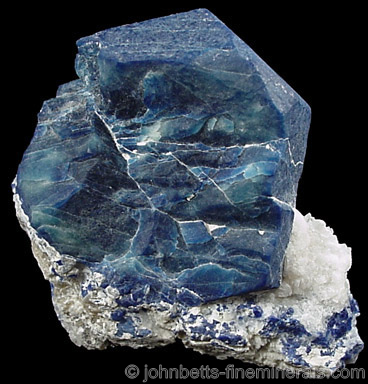The Mineral sodalite

Sodalite is known for its often bright-blue color, and it usually contains white veins or streaking. Specimens are often polished or sliced into slabs for collectors. Sodalite is named in reference to its sodium ("soda") content.
The variety Hackmanite is a sulfur-rich form of this mineral, and is prized for its lovely pink or purple color and strong fluorescence. When in a rare crystallized form, this variety is especially aesthetic. Hackmanite has a unique optical property called tenebrescence (also known as photochromism), in which its color will be more saturated after exposure to ultraviolet light and then eventually fade.
For additional information, see the gemstone section on Sodalite.
Chemical Formula
Na8Al6Si6O24Cl2
Color
Most often blue, less commonly purple, pink, gray, green, brown, white, and colorless. May also be multicolored blue with white and gray veins.
Varieties
-
Sulfur-rich variety of Sodalite, usually with a pink or purple color. The term Hackmanite is sometimes also be used to describe pale-colored Sodalite or Sodalite with fluorescence or tenebrescence. Hackmanite was named for Victor Axel Hackman (1866 - 1941), a noted geologist for the Finnish Geological Survey.
Uses
Sodalite is a minor blue opaque gemstone, and is used especially in beads. The variety Hackmanite from Afghanistan is a highly desired mineral among collectors.
Noteworthy Localities
The premier locality for Sodalite, where it occurs in large, well-formed crystals and also occurs in the Hackmanite variety, is the historic Lazurite mines at Sar-e-Sang, Kokcha Valley, Badakshan Province,
Afghanistan. Large blue Sodalite masses come from Poços de Caldas, Minas Gerais, Brazil; and tiny colorless crystals are found in Italy at Monte Somma, Vesuvius; and at Vico Lake, near Viterbo. The original type locality where this mineral was first described is the Ilimaussaq Alkaline Complex, Narsaq, Greenland.
Canada has several important localities. Perhaps the best-known is Dungannon Township, Hastings Co., Ontario,
Canada, where deep blue Sodalite is mined for gemstone use in the Princess Mine. Also in Dungannon is the Davis Quarry, which produces highly fluorescent
Hackmanite. Sodalite is also found in Mont Saint Hilaire, Quebec; and at Kicking Horse Pass and the Ice River, both in the Golden Mining Division, British Columbia.
In the U.S., Sodalite comes from Dennis Hill, Litchfield, Kennebec Co., Maine; and Magnet Cove, Hot Springs Co., Arkansas.
Common Mineral Associations
Calcite, Nepheline, Cancrinite
Distingushing Similar Minerals
Lazurite - Has a blue streak, usually associated with Pyrite.
Lazulite - Usually lacks white veins and is not fluorescent.
Azurite - Softer, has blue streak.